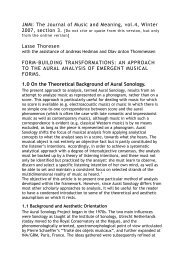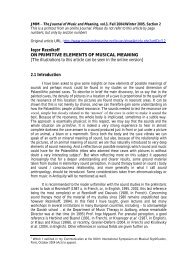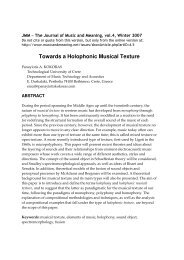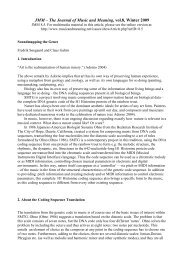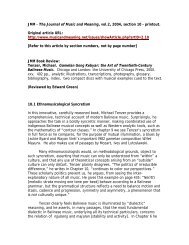The Use and Application of Proverbs in Basotho Accordion Music ...
The Use and Application of Proverbs in Basotho Accordion Music ...
The Use and Application of Proverbs in Basotho Accordion Music ...
You also want an ePaper? Increase the reach of your titles
YUMPU automatically turns print PDFs into web optimized ePapers that Google loves.
Peer-Reviewed Paper JMM: <strong>The</strong> Journal <strong>of</strong> <strong>Music</strong> <strong>and</strong> Mean<strong>in</strong>g, vol. 11, 2012/2013<br />
bear<strong>in</strong>g the basic mean<strong>in</strong>g <strong>of</strong> the proverbs. Thus, one learns that the artists are also aware <strong>of</strong><br />
the economic use <strong>of</strong> words. One might argue that, s<strong>in</strong>ce <strong>Basotho</strong> love proverbs, the artists<br />
have taken advantage <strong>of</strong> that fact to have their songs entitled <strong>in</strong> proverbs as a means <strong>of</strong><br />
pleas<strong>in</strong>g <strong>and</strong> entic<strong>in</strong>g potential buyers. Put another way, even though most <strong>of</strong> the artists are<br />
not well read, they have sound bus<strong>in</strong>ess acumen <strong>in</strong> market<strong>in</strong>g their products.<br />
6.2 <strong>Proverbs</strong> <strong>Use</strong>d to Expla<strong>in</strong> Others or <strong>Use</strong>d Synonymously<br />
This section <strong>in</strong>dicates that the artists <strong>in</strong> this music are very conversant with their use <strong>of</strong><br />
proverbs. That they sometimes use more than one proverb to summarize or refer to one<br />
<strong>in</strong>cident, shows that they are transmitt<strong>in</strong>g agents <strong>of</strong> oral literature; pass<strong>in</strong>g it from one<br />
generation to another with the aim <strong>of</strong> reta<strong>in</strong><strong>in</strong>g the richness <strong>of</strong> the Sesotho language. This<br />
practice shows the knowledge that one has <strong>in</strong> one’s own language where more than two<br />
proverbs are used to expla<strong>in</strong> certa<strong>in</strong> situations. This highlights their capability <strong>of</strong> master<strong>in</strong>g<br />
the Sesotho language <strong>in</strong> an era when many fear that oral literature is dy<strong>in</strong>g a natural death as<br />
future generations fail to actively engage with it.<br />
In the cassette Tšeole No.5 <strong>in</strong> the song, ‘Ngoan’a lekhala’ there are two proverbs. <strong>The</strong><br />
first one is ‘Ngoana oa lekhala o tsamaea ka lekeke joaloka m’ae’ which is used<br />
<strong>in</strong>terchangeably with ‘Ngoana oa tali o tsejoa ka mereto’ (both mean<strong>in</strong>g ‘like father like son,<br />
children take after their parents’). In another song, ‘Masoto a Thari’ the artist says ‘lenong ha<br />
le lapa lea solla’ (‘when one is <strong>in</strong> need, one w<strong>and</strong>ers about to make a liv<strong>in</strong>g’) which is used to<br />
give a supplementary explanation to another proverbial expression, ‘se etseng matsoho<br />
masoto a thari’ (‘one who avoids be<strong>in</strong>g <strong>in</strong>active at work, makes his life better’). Tšeole also<br />
has a third song entitled ‘Thuto-Boholo’ <strong>in</strong> which another proverb supplements another. <strong>The</strong><br />
proverb, ‘thupa e otlolloa e sa le metsi’ (‘it is worthwhile to mould a person at childhood’) is<br />
used to expla<strong>in</strong> or is synonymously used with ‘thuto-boholo e ea roba’ (‘it is not easy to<br />
<strong>in</strong>still changes for aged people’).<br />
<strong>The</strong> Matsie group, <strong>in</strong> their song ‘Moiketsi ha a lleloe’ (‘self-<strong>in</strong>fliction is no excuse for<br />
sympathy’), has the proverb ‘ngoan’a mahana a joetsoa o ka ‘mona ka likhapha ho lla’ (‘one<br />
who does not heed advice suffers’), which supplements another one ‘moiketsi ha a lleloe’.<br />
Poho-li -Matla No.5, <strong>in</strong> their song ‘Leboella lea ja’ (‘one’s go<strong>in</strong>g for the second<br />
experience results <strong>in</strong> disaster’) s<strong>in</strong>gs ‘motho o se ke be oa mo ts’epa, o ts’eha ka meno e ka oa<br />
u rata that is Meno a masoeu a phoma’ (‘dangerous people are those with st<strong>and</strong>ards’) which<br />
60




